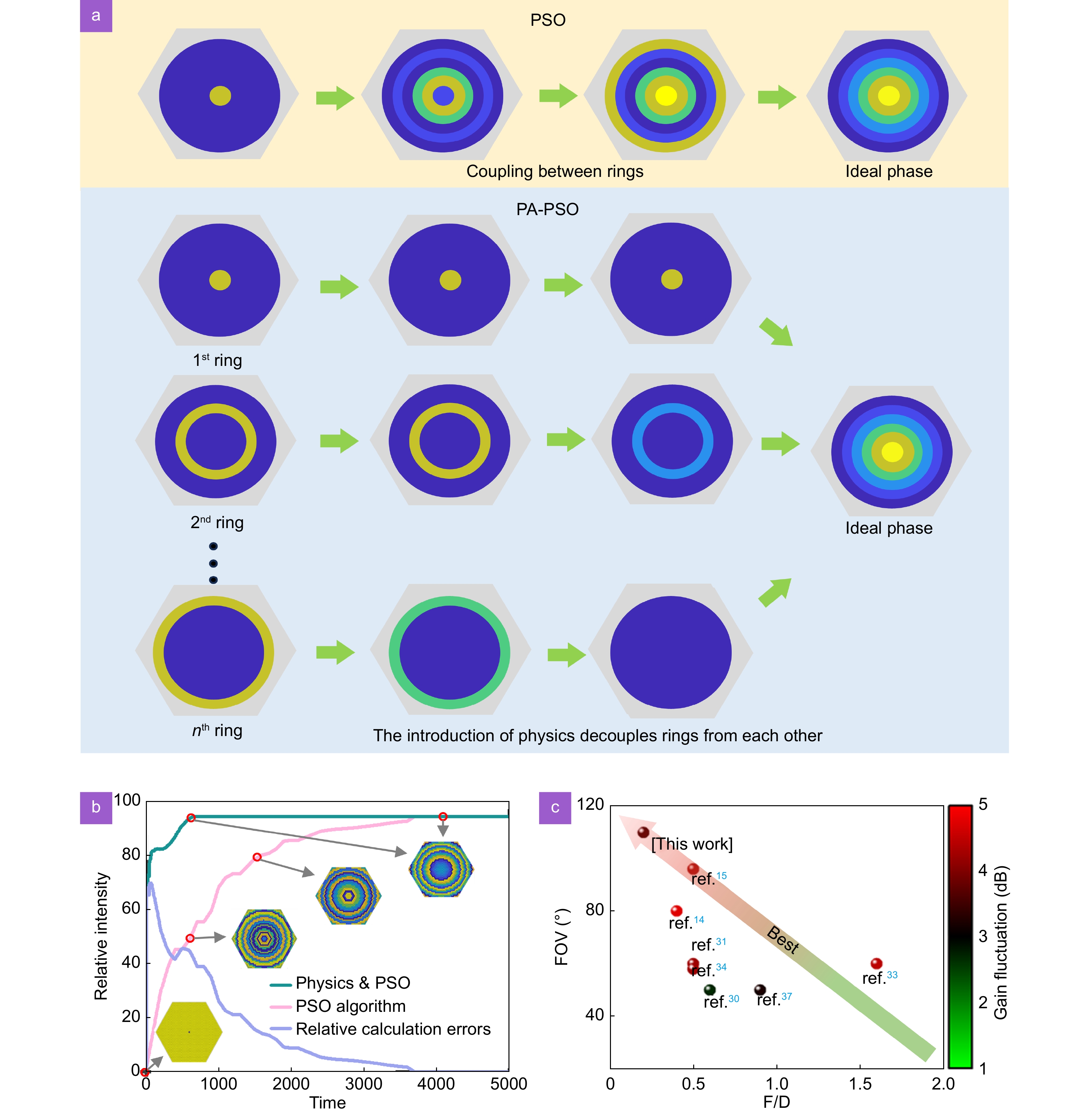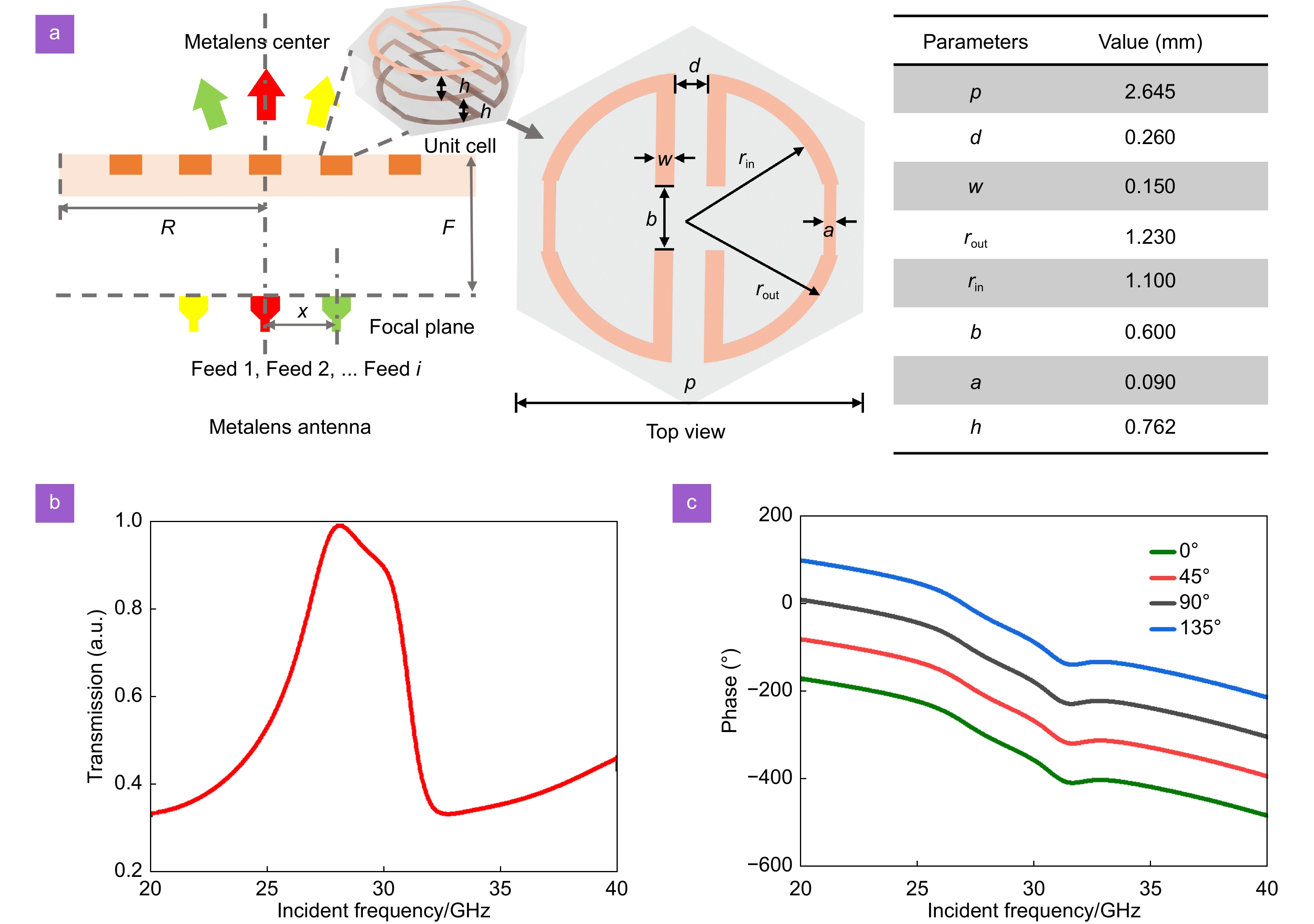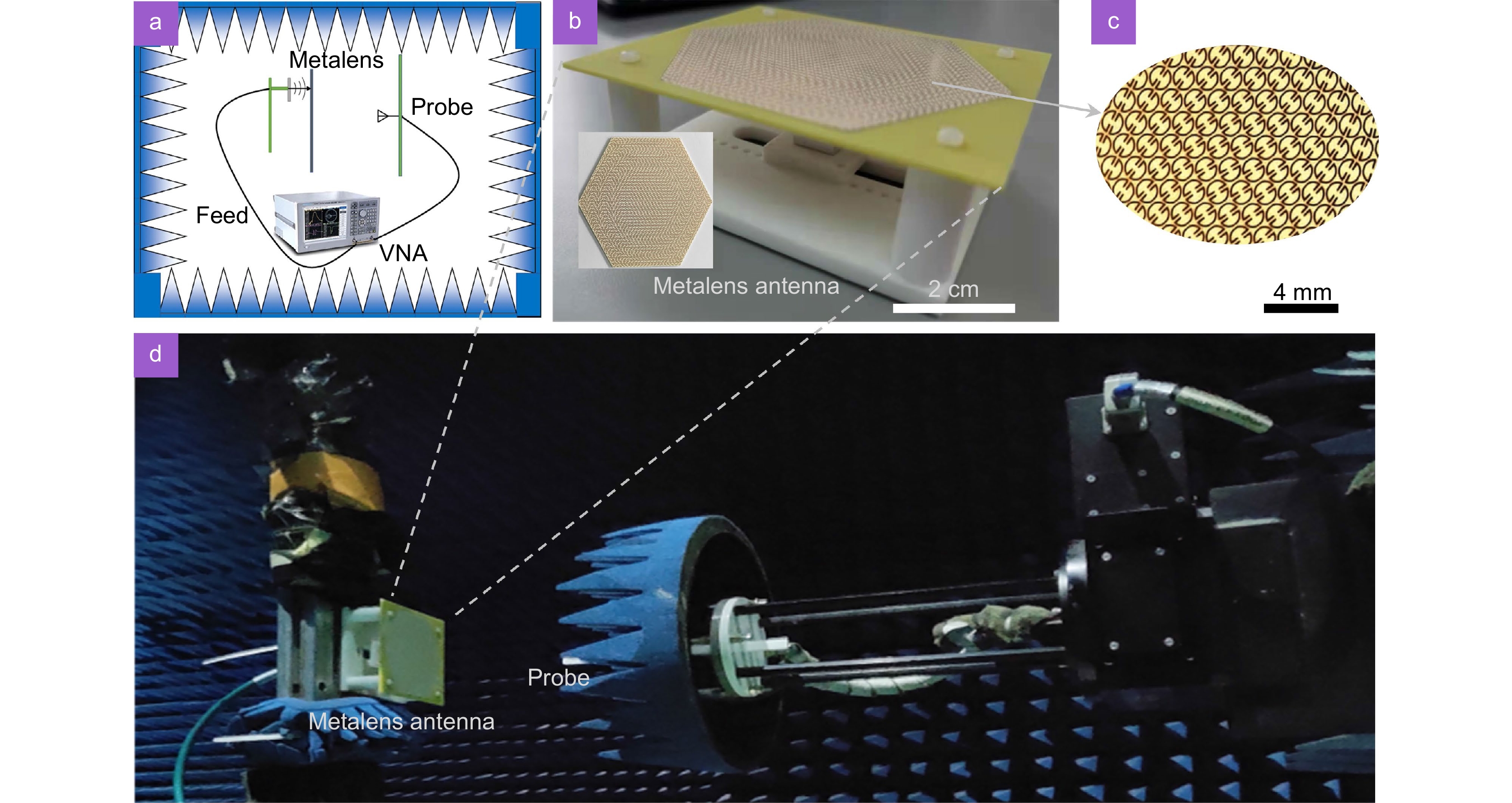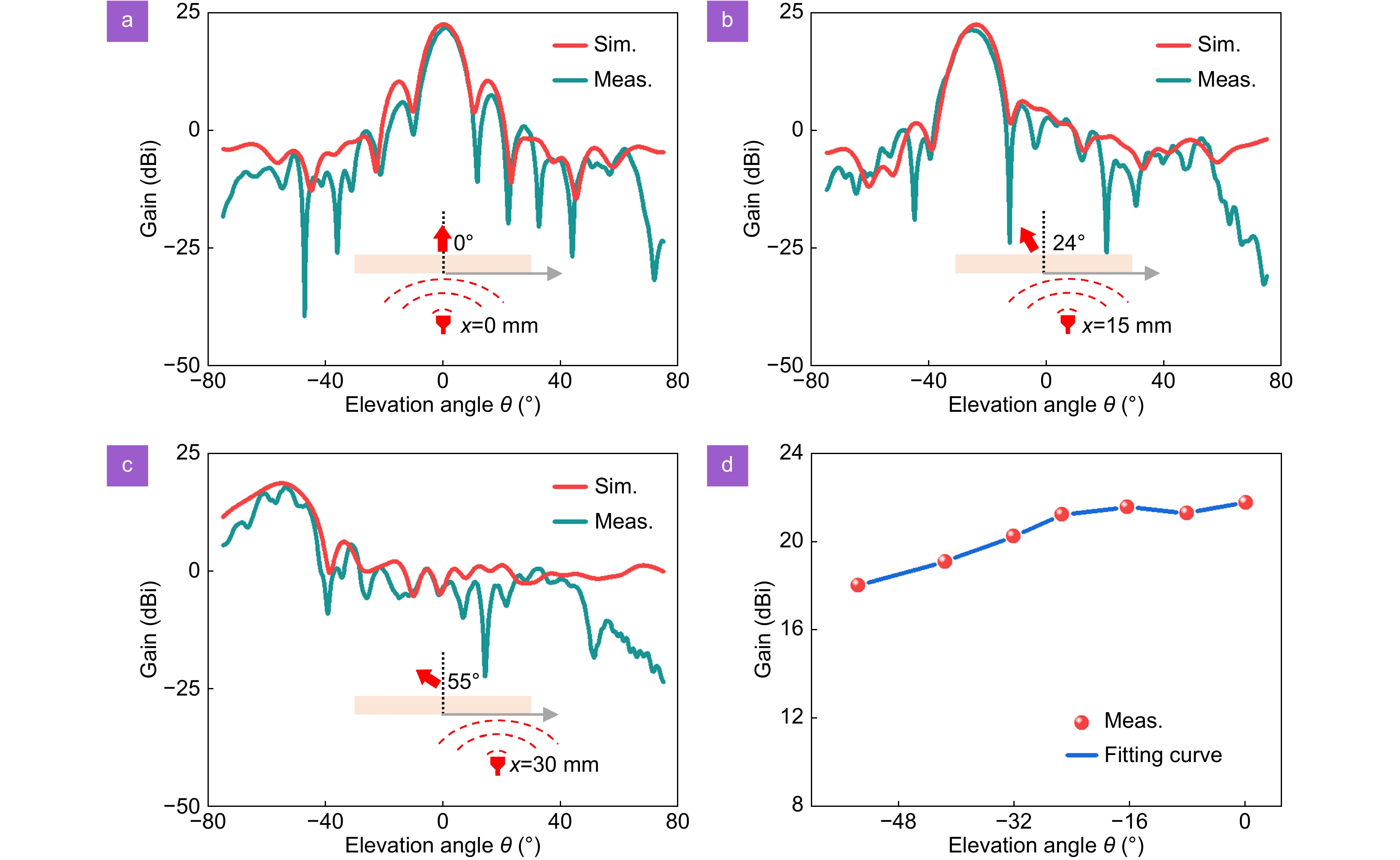| Citation: | Jiang SB, Deng WJ, Wang ZS et al. Ka-Band metalens antenna empowered by physics-assisted particle swarm optimization (PA-PSO) algorithm. Opto-Electron Sci 3, 240014 (2024). doi: 10.29026/oes.2024.240014 |
Ka-Band metalens antenna empowered by physics-assisted particle swarm optimization (PA-PSO) algorithm
-
Abstract
Design of multiple-feed lens antennas requires multivariate and multi-objective optimization processes, which can be accelerated by PSO algorithms. However, the PSO algorithm often fails to achieve optimal results with limited computation resources since spaces of candidate solutions are quite large for lens antenna designs. This paper presents a design paradigm for multiple-feed lens antennas based on a physics-assisted particle swarm optimization (PA-PSO) algorithm, which guides the swarm of particles based on laws of physics. As a proof of concept, a design of compact metalens antenna is proposed, which measures unprecedented performances, such as a field of view at ±55°, a 21.7 dBi gain with a flatness within 4 dB, a 3-dB bandwidth >12°, and a compact design with af-number of 0.2. The proposed PA-PSO algorithm reaches the optimal results 6 times faster than the ordinary PSO algorithm, which endows promising applications in the multivariate and multi-objective optimization processes, including but not limited to metalens antenna designs.-
Keywords:
- multiple-feed lens antennas /
- PA-PSO algorithm /
- metalens /
- metasurfaces /
- Ka-band antenna.
-

-
References
[1] Yue PY, An JP, Zhang JK et al. Low earth orbit satellite security and reliability: issues, solutions, and the road ahead. IEEE Commun Surv Tutor 25, 1604–1652 (2023). doi: 10.1109/COMST.2023.3296160 [2] Fkirin MA, Khira MAE. Enhanced antenna positioning control system using adapted DC servo motor and Fuzzy-PI controller. IEEE Access 11, 102661–102668 (2023). doi: 10.1109/ACCESS.2023.3313976 [3] Duan XC, Qiu YY, Mi JW et al. On the mechatronic servo bandwidth of a Stewart platform for active vibration isolating in a super antenna. Robot Comput Integr Manuf 40, 66–77 (2016). doi: 10.1016/j.rcim.2016.01.005 [4] Debruin J. Control systems for mobile Satcom antennas. IEEE Control Syst Mag 28, 86–101 (2008). doi: 10.1109/MCS.2007.910205 [5] Sadhu B, Tousi Y, Hallin J et al. A 28-GHz 32-element TRX phased-array IC with concurrent dual-polarized operation and orthogonal phase and gain control for 5G communications. IEEE J Solid-State Circuits 52, 3373–3391 (2017). doi: 10.1109/JSSC.2017.2766211 [6] Zhao K, Helander J, Sjoberg D et al. User body effect on phased array in user equipment for the 5G mmWave communication system. IEEE Antennas Wirel Propag Lett 16, 864–867 (2017). doi: 10.1109/LAWP.2016.2611674 [7] Maguid E, Yulevich I, Veksler D et al. Photonic spin-controlled multifunctional shared-aperture antenna array. Science 352, 1202–1206 (2016). doi: 10.1126/science.aaf3417 [8] Hao RS, Zhang JF, Jin SC et al. K-/Ka-band shared-aperture phased array with wide bandwidth and wide beam coverage for LEO satellite communication. IEEE Trans Antennas Propag 71, 672–680 (2023). doi: 10.1109/TAP.2022.3222091 [9] Lee J, Kim H, Oh J. Large-aperture metamaterial lens antenna for multi-layer MIMO transmission for 6G. IEEE Access 10, 20486–20495 (2022). doi: 10.1109/ACCESS.2022.3150037 [10] Qu ZS, Qu SW, Zhang Z et al. Wide-angle scanning lens fed by small-scale antenna array for 5G in millimeter-wave band. IEEE Trans Antennas Propag 68, 3635–3643 (2020). doi: 10.1109/TAP.2020.2967086 [11] Ansarudin F, Abd Rahman T, Yamada Y et al. Multi beam dielectric lens antenna for 5G base station. Sensors 20, 5849 (2020). doi: 10.3390/s20205849 [12] Wang C, Wu J, Guo YX. A 3-D-printed multibeam dual circularly polarized Luneburg lens antenna based on quasi-icosahedron models for Ka-band wireless applications. IEEE Trans Antennas Propag 68, 5807–5815 (2020). doi: 10.1109/TAP.2020.2983798 [13] Zhang N, Jiang WX, Ma HF et al. Compact high-performance lens antenna based on impedance-matching gradient-index metamaterials. IEEE Trans Antennas Propag 67, 1323–1328 (2019). doi: 10.1109/TAP.2018.2880115 [14] Hernandez CAM, Elmansouri M, Filipovic DS. High-directivity beam-steerable lens antenna for simultaneous transmit and receive. In 2019 IEEE International Symposium on Phased Array System & Technology 1–5 (IEEE, 2019); http://doi.org/10.1109/PAST43306.2019.9020904. [15] Imbert M, Romeu J, Baquero-Escudero M et al. Assessment of LTCC-based dielectric flat lens antennas and switched-beam arrays for future 5G millimeter-wave communication systems. IEEE Trans Antennas Propag 65, 6453–6473 (2017). doi: 10.1109/TAP.2017.2767821 [16] Wang Y, Fan Q, Xu T. Design of high efficiency achromatic metalens with large operation bandwidth using bilayer architecture. Opto-Electron Adv 4, 200008 (2021). doi: 10.29026/oea.2021.200008 [17] Deng W, Jiang S, Shi Y et al. Mid‐infrared dynamic wavefront transformer based on a two‐degrees‐of‐freedom control system. Laser Photonics Rev 16, 2200152 (2022). doi: 10.1002/lpor.202200152 [18] Zhu RC, Wang JF, Qiu TS et al. Remotely mind-controlled metasurface via brainwaves. eLight 2, 10 (2022). doi: 10.1186/s43593-022-00016-0 [19] Feng ZW, Shi T, Geng GZ et al. Dual-band polarized upconversion photoluminescence enhanced by resonant dielectric metasurfaces. eLight 3, 21 (2023). doi: 10.1186/s43593-023-00054-2 [20] Nan T, Zhao H, Guo J et al. Generation of structured light beams with polarization variation along arbitrary spatial trajectories using tri-layer metasurfacess. Opto-Electron Sci 3, 230052 (2024). doi: 10.29026/oes.2024.230052 [21] Biswas S, Lu A, Larimore Z et al. Realization of modified Luneburg lens antenna using quasi-conformal transformation optics and additive manufacturing. Microw Opt Technol Lett 61, 1022–1029 (2019). doi: 10.1002/mop.31696 [22] Li YJ, Ge L, Chen ME et al. Multibeam 3-D-printed Luneburg lens fed by magnetoelectric dipole antennas for millimeter-wave MIMO applications. IEEE Trans Antennas Propag 67, 2923–2933 (2019). doi: 10.1109/TAP.2019.2899013 [23] Liu KN, Yang SW, Qu SW et al. Phased hemispherical lens antenna for 1-D wide-angle beam scanning. IEEE Trans Antennas Propag 67, 7617–7621 (2019). doi: 10.1109/TAP.2019.2934815 [24] Zhang F, Pu MB, Li X et al. Extreme-angle silicon infrared optics enabled by streamlined surfaces. Adv Mater 33, 2008157 (2021). doi: 10.1002/adma.202008157 [25] Ha YL, Luo Y, Pu MB et al. Physics-data-driven intelligent optimization for large-aperture metalenses. Opto-Electron Adv 6, 230133 (2023). doi: 10.29026/oea.2023.230133 [26] Zhang HC, Zhang X, Ma XL et al. Full-space beam scanning based on transmission reflection switchable quadratic phase metasurface. Opt Express 30, 36949–36959 (2022). doi: 10.1364/OE.472546 [27] Guo YH, Zhang ZJ, Pu MB et al. Spoof plasmonic metasurfaces with catenary dispersion for two-dimensional wide-angle focusing and imaging. iScience 21, 145–156 (2019). doi: 10.1016/j.isci.2019.10.019 [28] Shi YZ, Song QH, Toftul I et al. Optical manipulation with metamaterial structures. Appl Phys Rev 9, 031303 (2022). doi: 10.1063/5.0091280 [29] Gao H, Fan XH, Wang YX et al. Multi-foci metalens for spectra and polarization ellipticity recognition and reconstruction. Opto-Electron Sci 2, 220026 (2023). doi: 10.29026/oes.2023.220026 [30] Lima EB, Matos SA, Costa JR et al. Circular polarization wide-angle beam steering at Ka-band by in-plane translation of a plate lens antenna. IEEE Trans Antennas Propag 63, 5443–5455 (2015). doi: 10.1109/TAP.2015.2484419 [31] Pham K, Nguyen NT, Clemente A et al. Design of wideband dual linearly polarized transmitarray antennas. IEEE Trans Antennas Propag 64, 2022–2026 (2016). doi: 10.1109/TAP.2016.2536160 [32] Wang HF, Wang ZB, Wu ZH et al. Beam-scanning lens antenna based on elliptical paraboloid phase distribution metasurfaces. IEEE Antennas Wirel Propag Lett 18, 1562–1566 (2019). doi: 10.1109/LAWP.2019.2922695 [33] Lou Q, Chen ZN. Sidelobe suppression of metalens antenna by amplitude and phase controllable metasurfaces. IEEE Trans Antennas Propag 69, 6977–6981 (2021). doi: 10.1109/TAP.2021.3076312 [34] Jiang M, Chen ZN, Zhang Y et al. Metamaterial-based thin planar lens antenna for spatial beamforming and multibeam massive MIMO. IEEE Trans Antennas Propag 65, 464–472 (2017). doi: 10.1109/TAP.2016.2631589 [35] Jain M, Saihjpal V, Singh N et al. An overview of variants and advancements of PSO algorithm. Appl Sci 12, 8392 (2022). doi: 10.3390/app12178392 [36] Liu YJ, Zhang AX, Xu Z et al. Wideband and low-profile transmitarray antenna using transmissive metasurface. J Appl Phys 125, 045103 (2019). doi: 10.1063/1.5061787 [37] Matos SA, Lima EB, Silva JS et al. High gain dual-band beam-steering transmit array for satcom terminals at Ka-band. IEEE Trans Antennas Propag 65, 3528–3539 (2017). doi: 10.1109/TAP.2017.2702658 [38] Weigand S, Huff GH, Pan KH et al. Analysis and design of broad-band single-layer rectangular U-slot microstrip patch antennas. IEEE Trans Antennas Propag 51, 457–468 (2003). doi: 10.1109/TAP.2003.809836 [39] Ansari JA, Brij Ram R. Analysis of broad band U-slot microstrip patch antenna. Microw Opt Technol Lett 50, 1069–1073 (2008). doi: 10.1002/mop.23274 [40] Lee KF, Luk KM, Mak KM et al. On the use of U-slots in the design of dual-and triple-band patch antennas. IEEE Antennas Propag Mag 53, 60–74 (2011). doi: 10.1109/MAP.2011.6028422 [41] Pu MB, Li X, Guo YH et al. Nanoapertures with ordered rotations: symmetry transformation and wide-angle flat lensing. Opt Express 25, 31471–31477 (2017). doi: 10.1364/OE.25.031471 -
Supplementary Information
Supplementary information for Ka-Band metalens antenna empowered by physics-assisted particle swarm optimization (PA-PSO) algorithm 
-
Access History

Article Metrics
-
Figure 1.
Schematics of the PA-PSO algorithm. (a) and (b) Working principle of the metalens antenna. (c) and (d) Comparison between the traditional PSO and PA-PSO algorithm. The red and blue stars represent optimal and sub-optimal designs, respectively. The red dots and dashed arrows represent the positions and velocities of the particles, respectively. (c) The working principle of the PSO algorithm where the swarm of particles is guided by the radiation intensity. (d) The PA-PSO algorithm guides the swarm of particles based on the extrema condition of the radiation intensity, which shows the correct directions of the maximum radiation intensity. This approach guides the swarm of particles more efficiently, which reduces not only the computation time but also the likelihood of finding sub-optimal designs.
-
Figure 2.
Architecture and performance of the PA-PSO algorithm. (a) Difference between PSO and PA-PSO algorithms. The yellow background in the image represents the optimization process of the PSO algorithm. During this optimization process, the phase changes between the rings are coupled, requiring more iteration time. The blue background indicates that after introducing physics, the optimization between the rings is decoupled, and they do not influence each other. As a result, the number of optimization iterations naturally decreases. (b) Variation of the relative electric field intensity with respect to the times of iteration for PA-PSO and PSO algorithms. The purple line shows the calculation errors. The four hexagons from bottom to top represent phase distributions at different stages: initial phase distribution, PSO algorithm iteration 650 times, PSO algorithm iteration
1500 times, and PSO algorithm iteration4100 times (PA-PSO algorithm iteration 650 times). (c) Comparison of FOVs and F/D for planar lens antennas. The colors of the points indicate the fluctuation of gains when scanning within the field of view range. -
Figure 3.
Design and Characteristics of the metalens antenna. (a) Design parameters of the unit structure of the metalens antenna. (b) Transmission spectrum of the unit cells. (c) Phase spectra of unit cells when the unit cell is rotated with respect to the fast axis of the left circularized incident light.
-
Figure 4.
Device fabrication and experimental setup. (a) Schematic of the experimental setup for near-field measurement. (b) The fixture and metasurface lens antenna used in the test. The bottom of the fixture holds the feed source antenna and includes insertable holes to alter the position of the feed source. The distance from the feed source to the metasurface lens is 2.2 cm. (c) A enlarged view of the metamaterial lens. (d) Photograph of the experimental setup. The experimental setup consists of probes, assembled feed source antenna, metasurface lens, and a vector network analyzer connecting the probes and feed source antenna.
-
Figure 5.
Gain profiles of the metalens antenna when the feed is placed on the focal plane with different displacements x. Comparison between the experimental results (blue lines) and simulation results (red lines) when the feed source position is (a) at x = 0, showing a maximum gain of 21.7 dBi, which corresponds to an angle of 0°; (b) at x = 15 mm, showing a maximum gain is 21.2 dBi, which corresponds to an angle of 24°; (c) at x = 30 mm, showing a maximum gain is 18.3 dBi, which corresponds to an angle of 55°. (d) The relationship between the maximum gain angles and the corresponding gains obtained from testing the feed source at different positions.

 E-mail Alert
E-mail Alert RSS
RSS
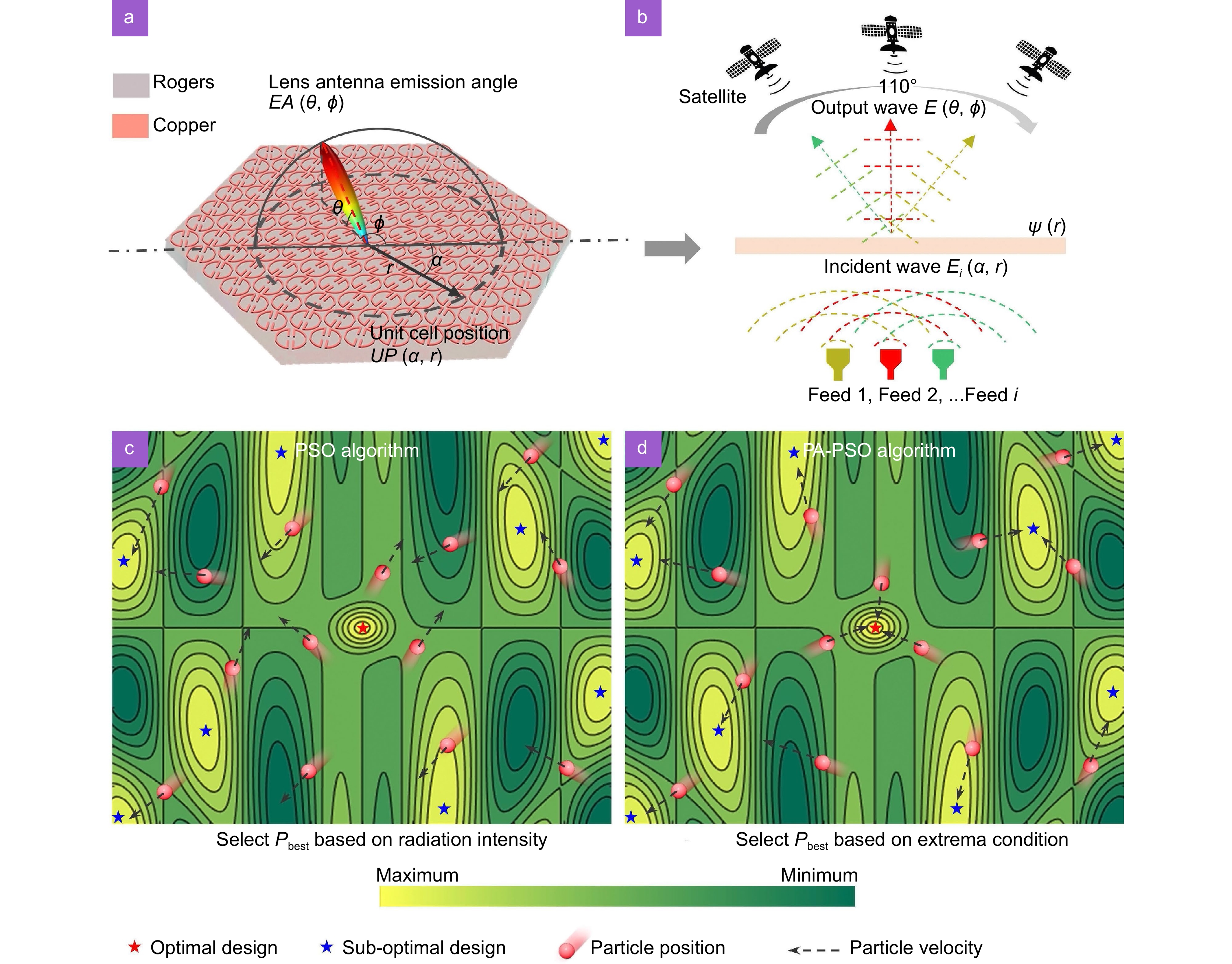

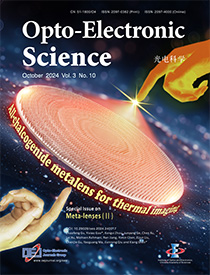
 DownLoad:
DownLoad:
